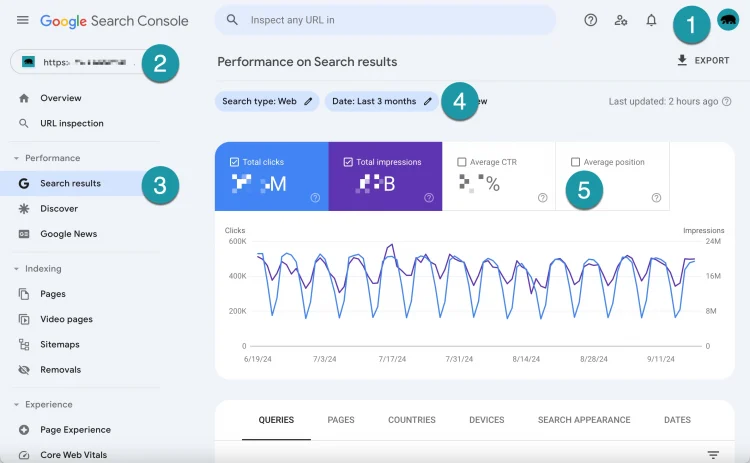
When it comes to your site rankings, you probably know which terms you’re showing on Page 1 for—these are your branded terms and the non-branded gems that you actively defend using on-page best practices and content optimizations.
But what are these striking-distance keywords that SEOs keep mentioning, and why do they matter?
What are striking-distance keywords?
Striking-distance keywords are search terms that your site ranks for, but you’re usually stuck between positions 11 and 30 in Google. The reason we SEOs come back to these keywords regularly is because they’re within reach (hence the name) and it’s a great strategy for boosting traffic and rankings when you’re feeling stuck.
With the right targeted efforts, optimizing these pages can potentially result in quick SEO gains. And, rather than starting from scratch, you can do this by refining existing content, making it a more cost-effective strategy for driving results. This lower barrier to entry combined with the potential for quick wins makes striking-distance keyword optimization an essential part of a successful SEO strategy.
Can moving just a few positions really help organic traffic?
Yes, like the Tanzanian proverb says, “Little by little, a little becomes a lot.”
Small changes in positions can lead to significant changes in CTR, growing your existing organic traffic. For example:
- Click-through-rates for positions on the second page average less than 1%
- Moving that keyword to the bottom of the first page will almost triple CTR.
- A keyword ranking in the first position has 10x the CTR as one ranking at the bottom of the first page.
SISTRIX (among others) published a chart of CTRs based on search results for 80 million keywords that shows how dramatically the CTR can be by moving just a few positions.

While it is important to remember that the CTR will depend on the type of keyword (brand vs. non-brand), search intent, and SERP features, moving up just one position can significantly impact the traffic you receive.
How to find (quality) striking-distance keywords
To effectively target striking-distance keywords, you need to first identify them for your site. The process below will identify these high-potential keywords for your site, but remember, it isn’t just where you are ranking, it is which keywords are ranking, and how the SERPs look for those terms.
- Use SEO Tools: Sites like Google Search Console (GSC), Ahrefs, and SEMrush (links to free versions of their ranking tools) can help you identify which keywords your site is ranking for on the second and third page (traditionally between positions 11 and 30).
- Analyze Search Volume: If your keyword is so incredibly specific, nuanced, or rarely used that it could have been a Googlewhack contender (a term with exactly one search result), ranking #1 won’t drive additional traffic. Look for keywords with a good balance of low competition and high search volume.
- Manual Searches: Tools are invaluable, but the SERP landscape is in a constant state of flux. Conduct manual searches for your target keywords and note where your website ranks. Pay attention to the relevance and quality of top-ranking pages for that phrase, the presence of SERP features, and the competitiveness of the keyword.
- Discard the low-quality keywords: Ensure the keywords you’re targeting are actually used by people when they’re searching and that they align with your content and business goals.
Using Google Search Console (GSC) to find striking-distance keywords.
Before signing up for tools that cost hundreds to thousands of dollars per month, utilize GSC to identify keywords with an average rank of 11 to 30. The impression data in the performance > search results report can provide a high-level estimate of the keyword’s popularity.
Finding your striking-distance keywords:
- Log into your Google Search Console account.
- Select the property you want to analyze.
- Navigate to the “Search results” report in the Performance section of the left sidebar.
- Set the date range to cover a significant period (e.g., last 3-6 months).
- Ensure “Average position” is selected as a metric, along with Clicks and Impressions.

Filtering for striking distance keywords:
- Click on the inverted caret above the last column in the table. Here, you can filter by position (e.g., smaller than 30) and impressions. This will filter out results that are not essential to the process.
- Sort by the different rows (queries, position, impressions, and clicks), looking for similar terms with high impressions, closest to the 11th position.
- Click on an individual keyword and then click on the “PAGES” tab to view whether more than one URL from your site is ranking for that particular term. This will help you identify potential keyword cannibalization and allow you to choose which page to optimize.
- If you want to apply multiple filters to the data, simply click the export button at the top-right of the page to view the table in Google Sheets, Excel, or another spreadsheet software.
Choosing a short-list of keywords to optimize:
Begin by prioritizing the keywords with the highest potential (highest impressions) and lowest effort required (ranking closest to 11). Analyze the current search results for those keywords, looking for AI Overviews or SERP features that could rob potential CTR improvements. Review the sites that are ranking on the first page. Are they direct competitors? Are they internet juggernauts that will be difficult to usurp? Examining the competition on the SERP and the sites that Google is prioritizing above yours will help you see ways to enhance your content.
How to optimize striking-distance keywords
Once you have identified some striking-distance keywords, the next step is to begin optimizing your content (and possibly, your site) to improve rankings and hopefully move your site onto page 1.
- Content Optimization: Review the content on the page that’s ranking for your striking distance keyword. Update it (and do so regularly) to ensure it is comprehensive, relevant, and aligns with user intent. Adding more detailed information, examples, FAQs, or multimedia elements will help EEAT and can make your content more appealing to both users and search engines.
- On-Page SEO: Optimize titles, meta descriptions, and headers to include your targeted keyword(s). Ensure your content is well-structured and easy to read, as this can improve user engagement and dwell time.
- Internal Linking: Strengthen your internal linking strategy by linking from high-authority pages to those that target your striking distance keywords. This can help distribute link equity and improve the ranking potential of those pages.
- External Backlink Building: Acquire high-quality backlinks to pages targeting striking distance keywords. Backlinks are a significant ranking factor, and improving your backlink profile can boost your page’s authority and visibility.
- User Experience: Ensure your website offers a good user experience, with fast loading times and a mobile-friendly design. Google considers user experience signals when ranking pages, so optimizing these aspects can indirectly benefit your SEO efforts.
Conclusion
By incorporating striking-distance keywords into your SEO strategy, you can achieve significant improvements in your search engine rankings and organic traffic. This approach allows you to capitalize on existing content and make data-driven decisions for optimization.
Remember, SEO is an ongoing process, so continue to analyze, refine, and adapt your strategy as you see results and as search algorithms evolve.
